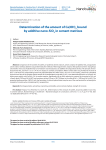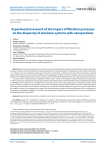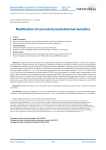Research results of the leading scientists. Рубрика в журнале - Nanotechnologies in Construction: A Scientific Internet-Journal

Determination of the amount of Ca(OH)2 bound by additive nano-SiO2 in cement matrices
Статья научная
Comparison of the content of Ca(OH)2 in hardened cement matrices, which contains the additive SiO2 nanoparticles and in matrice without additives was performed by the method of thermogravimetric analysis. Alite portland cement «SsangYong» and «Denki» were used. Hydrothermal sol of «Geosil» was introduced as an additive of nanoparticles of SiO2. The amount of introduced nano-SiO2 was from 1.15 to 1.74 wt.% in respect to cement consumption. Water-cement ratio was provided at the level of W/C = 0.39–0.26. The compensating amount of polycarboxylate SVC-5Neu was 0.2–0.77 wt. %. The Ca(OH)2 content was calculated from the mass loss of the cement matrice sample in the temperature range 460–510оC. It was determined that the sol «Geosil» additive reacts quickly with Ca(OH)2 (CH) in cement matrice, significantly (up to 40%) reducing its content. By the period of 24 h sol «Geosil» binds 750 [mg CaO /g SiO2] and continues to bind CH up to 100–700 days, to the value δCaO = 1300 [mg CaO /g SiO2]. The pozzolan binding reaction Ca(OH)2 with the formation of calcium hydrosilicates may be one of the mechanisms for increasing the strength of concrete when introducing SiO2 nanoparticles.
Бесплатно

Статья научная
Hydrocarbon based emulsions are actively used as technological fluids in the processes of oil and gas wells construction, drilling-in, workover, and in the improved oil recovery methods such as intensification of oil production, water shut-off and others [1, 2]. However, the area of effective application of emulsion compositions is determined by their physical properties. Classical hydrocarbon emulsions have low thermal stability and lose aggregative stability in reservoir conditions, due to the coalescence of globules of the dispersed phase, which leads to a decrease in the technological efficiency of their use in high-temperature formations. The authors of the article propose a modification of the emulsion system by the addition of silicon dioxide (SiO2) nanoparticles in order to improve its properties. Previously, the results of experimental studies of thermal stability, which revealed the advantages of modified emulsion system with nanoparticles over classical emulsions were presented. [3]. The comparative analysis of the results of laboratory studies on the emulsion system with nanoparticles dispersity after filtration in porous media using optical microscopy is presented in article. Based on the analysis it was revealed that after filtration in natural rock cores the dispersity of the emulsion system with nanoparticles increased, and that phenomenon might be described by absence of the coalescence in the emulsion, and globules breakdown to smaller size during filtration through the porous media of rock cores from Abdulovskoe and Yugomashevskoe oil-gas fields.
Бесплатно

Modification of concrete by hydrothermal nanosilica
Статья научная
The paper shows the possibility to use hydrothermal nanosilica as a modifying additive to increase the strength of concrete based on portland cement. The technology of obtaining hydrothermal nanosilica in the form of sols and nanopowders by ultrafiltration membrane concentration and cryochemical vacuum sublimation is proposed. The results of increased strength of concrete under compression by the addition of hydrothermal nanosilica Sol are presented. The experiments were performed on highly mobile concretes (ST = 10–19 cm) on equal-moving mixtures with water-cement ratio W/C = 0.61–0.71 at a dose of SiO2 2 wt.% and the rate of superplasticizer polycarboxylate 0.95±0.05 mas.% by cement. At the initial stage of hardening when the age is 1 day, the increase in the compressive strength of concrete reached 90–128% compared to the control sample. At the age of 28 days the increase in strength was 40%. High chemisorption activity of hydrothermal nanopowder with respect to Ca(OH)2 was determined in the experiment with lime medium. This indicates that the amorphous nanoadditive SiO2, which has a high specific surface area, causes the formation of high-strength hydrates of calcium silicates in the cement (lime) medium as a result of the pozzolan reaction, and this causes an increase in the strength of concrete.
Бесплатно

The formation of the sol-gel nanostructures of road bitumen by selecting chemical group composition
Статья научная
The studies of paving bitumen chemical composition and physicochemical properties produced by compounding deeply oxidized bitumen, tar and vacuum gas-oil of different hydrocarbon composition are carried out. The bitumen is marked to have the optimal complex of properties if the best chemical group composition of three main elements bitumen binding agents – oils, resins and asphaltenes - is formed. That provides the best structure of bitumen oildisperse system. The object of the research is the selection of compounded paving bitumen chemical group composition that provides the formation of bitumen nanodisperse system as «sol-gel» which quality metrics match the requirements of the new State Standard 33133-2014 «Petroleum paving viscous bitumen». The analysis of the research results makes it possible to determine the optimal chemical group composition of compounded bitumen that meets standard requirements by physicochemical properties. It has been determined that the higher the bitumen dispersion is, the more plastic properties it has. In addition, the bitumen ability to thermal-oxidative processes of deterioration decreases. The value range of bitumen dispersion and the most optimal values of asphaltenes ratio to the amount of oils and resins for bitumen grade BND 100/130 and for bitumen grade BND 70/100 were found. This amount of oils and resins for referred bitumen grades provide production of nanostructured bitumen as «sol-gel». It is shown that when processing tar of different chemical composition the optimal chemical group composition of finished product can be formed by compounding. That rises probability that the end product will fit to the new State Standard 33133-2014. The represented results of the research can be used in fabrication as the modern laboratories of the oil-refining enterprises can determine quite efficiently the chemical composition of oil products used in compounding processes in bitumen binding agents production.
Бесплатно

